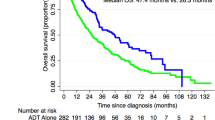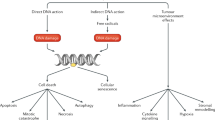Abstract
This Review focuses on the adverse effects of radical radiotherapy for localized prostate cancer. The adverse effects are described in the context of alternative treatment modalities. First, we consider the methodological issues that make comparison between the different treatment modalities problematic. Such issues include differences in baseline levels of urinary, bowel and sexual dysfunction, the importance of using patient-reported outcomes and the distinction between actuarial and prevalence rates of treatment-related toxic effects. Second, we describe the pattern of adverse effects that occur over time after radiotherapy. Here, we focus on evidence for a beneficial effect of radiotherapy on some urinary symptoms, and the controversy regarding the risk of secondary malignancy. Third, predictors of radiation toxicity are discussed. Accurate prediction of radiotherapy toxicity would be an invaluable tool for treatment individualization. It is noteworthy that the data on the adverse effects of prostate radiotherapy necessarily relate to treatment as it was delivered in the past. It is likely that recent technical advances, such as intensity modulation and image guidance, will further improve the toxicity profile of prostate radiotherapy.
Key Points
-
Studies of treatment-related toxic effects should include analysis of pretreatment functional status, patient-reported outcomes and the use of prevalence, rather than cumulative, rates of toxicity
-
Data from the SPCG7 trial show that the addition of prostate radiotherapy has only a modest impact on mean urinary, bowel and sexual bother in men receiving hormone treatment
-
Pretreatment bowel function and prior abdomino-pelvic surgery are important predictors of late rectal toxicity after prostate radiotherapy
-
Obstructive lower urinary tract symptoms typically improve after prostate radiotherapy
-
Any additional risk of rectal cancer after prostate radiotherapy remains uncertain
-
Intensity modulated radiotherapy and image-guided radiotherapy have the potential to further improve the therapeutic index of prostate radiotherapy
This is a preview of subscription content, access via your institution
Access options
Subscribe to this journal
Receive 12 print issues and online access
$209.00 per year
only $17.42 per issue
Buy this article
- Purchase on Springer Link
- Instant access to full article PDF
Prices may be subject to local taxes which are calculated during checkout




Similar content being viewed by others
References
Stephenson, A. J. et al. Prostate cancer-specific mortality after radical prostatectomy for patients treated in the prostate-specific antigen era. J. Clin. Oncol. 27, 4300–4305 (2009).
Brandeis, J. M. et al. Quality of life outcomes after brachytherapy for early stage prostate cancer. J. Urol. 163, 851–857 (2000).
Arterbery, V. E. et al. Quality of life after permanent prostate implant. Semin. Surg. Oncol. 13, 461–464 (1997).
Sanda, M. G. et al. Quality of life and satisfaction with outcome among prostate-cancer survivors. N. Engl. J. Med. 358, 1250–1261 (2008).
Litwin, M. S., Lubeck, D. P., Henning, J. M. & Carroll, P. R. Differences in urologist and patient assessments of health related quality of life in men with prostate cancer: results of the CaPSURE database. J. Urol. 159, 1988–1992 (1998).
Christie, D. et al. Delayed rectal and urinary symptomatology in patients treated for prostate cancer by radiotherapy with or without short term neo-adjuvant androgen deprivation. Radiother. Oncol. 77, 117–125 (2005).
Lancar, R., Kramar, A. & Haie-Meder, C. Non-parametric methods for analysing recurrent complications of varying severity. Stat. Med. 14, 2701–2712 (1995).
Widmark, A. et al. Endocrine treatment, with or without radiotherapy, in locally advanced prostate cancer (SPCG-7/SFUO-3): an open randomised phase III trial. Lancet 373, 301–308 (2009).
Fransson, P. et al. Quality of life in patients with locally advanced prostate cancer given endocrine treatment with or without radiotherapy: 4-year follow-up of SPCG-7/SFUO-3, an open-label, randomised, phase III trial. Lancet Oncol. 10, 370–380 (2009).
Osoba, D., Rodrigues, G., Myles, J., Zee, B. & Pater, J. Interpreting the significance of changes in health-related quality-of-life scores. J. Clin. Oncol. 16, 139–144 (1998).
Theobald, D. E. Cancer pain, fatigue, distress, and insomnia in cancer patients. Clin. Cornerstone 6 (Suppl. 1D), S15–S21 (2004).
Pirl, W. F., Greer, J. A., Goode, M. & Smith, M. R. Prospective study of depression and fatigue in men with advanced prostate cancer receiving hormone therapy. Psychooncology 17, 148–153 (2008).
Dearnaley, D. P. et al. The early toxicity of escalated versus standard dose conformal radiotherapy with neo-adjuvant androgen suppression for patients with localised prostate cancer: results from the MRC RT01 trial (ISRCTN47772397). Radiother. Oncol. 83, 31–41 (2007).
Kleinerman, R. A. et al. Second primary cancer after treatment for cervical cancer. An international cancer registries study. Cancer 76, 442–452 (1995).
Travis, L. B. et al. Second malignant neoplasms among long-term survivors of ovarian cancer. Cancer Res. 56, 1564–1570 (1996).
Travis, L. B. et al. Risk of second malignant neoplasms among long-term survivors of testicular cancer. J. Natl Cancer Inst. 89, 1429–1439 (1997).
Dores, G. M. et al. Second malignant neoplasms among long-term survivors of Hodgkin's disease: a population-based evaluation over 25 years. J. Clin. Oncol. 20, 3484–3494 (2002).
Brenner, D. J., Curtis, R. E., Hall, E. J. & Ron, E. Second malignancies in prostate carcinoma patients after radiotherapy compared with surgery. Cancer 88, 398–406 (2000).
Neugut, A. I., Ahsan, H., Robinson, E. & Ennis, R. D. Bladder carcinoma and other second malignancies after radiotherapy for prostate carcinoma. Cancer 79, 1600–1604 (1997).
Bhojani, N. et al. The rate of secondary malignancies after radical prostatectomy versus external beam radiation therapy for localized prostate cancer: a population-based study on 17,845 patients. Int. J. Radiat. Oncol. Biol. Phys. 76, 342–348 (2010).
Baxter, N. N., Tepper, J. E., Durham, S. B., Rothenberger, D. A. & Virnig, B. A. Increased risk of rectal cancer after prostate radiation: a population-based study. Gastroenterology 128, 819–824 (2005).
Kendal, W. S., Eapen, L., Macrae, R., Malone, S. & Nicholas, G. Prostatic irradiation is not associated with any measurable increase in the risk of subsequent rectal cancer. Int. J. Radiat. Oncol. Biol. Phys. 65, 661–668 (2006).
Andreyev, J. Gastrointestinal symptoms after pelvic radiotherapy: a new understanding to improve management of symptomatic patients. Lancet Oncol. 8, 1007–1017 (2007).
Fellin, G. et al. Clinical and dosimetric predictors of late rectal toxicity after conformal radiation for localized prostate cancer: results of a large multicenter observational study. Radiother. Oncol. 93, 197–202 (2009).
van Tol-Geerdink, J. J. et al. Do patients with localized prostate cancer treatment really want more aggressive treatment? J. Clin. Oncol. 24, 4581–4586 (2006).
Gore, J. L., Kwan, L., Lee, S. P., Reiter, R. E. & Litwin, M. S. Survivorship beyond convalescence: 48-month quality-of-life outcomes after treatment for localized prostate cancer. J. Natl Cancer Inst. 101, 888–892 (2009).
Vora, S. A., Wong, W. W., Schild, S. E., Ezzell, G. A. & Halyard, M. Y. Analysis of biochemical control and prognostic factors in patients treated with either low-dose three-dimensional conformal radiation therapy or high-dose intensity-modulated radiotherapy for localized prostate cancer. Int. J. Radiat. Oncol. Biol. Phys. 68, 1053–1058 (2007).
Zelefsky, M. J. et al. High dose radiation delivered by intensity modulated conformal radiotherapy improves the outcome of localized prostate cancer. J. Urol. 166, 876–881 (2001).
Al-Mamgani, A., Heemsbergen, W. D., Peeters, S. T. & Lebesque, J. V. Role of intensity-modulated radiotherapy in reducing toxicity in dose escalation for localized prostate cancer. Int. J. Radiat. Oncol. Biol. Phys. 73, 685–691 (2009).
Chung, H. T., Xia, P., Chan, L. W., Park-Somers, E. & Roach, M. 3rd. Does image-guided radiotherapy improve toxicity profile in whole pelvic-treated high-risk prostate cancer? Comparison between IG-IMRT and IMRT. Int. J. Radiat. Oncol. Biol. Phys. 73, 53–60 (2009).
Hall, E. J. & Wuu, C. S. Radiation-induced second cancers: the impact of 3D-CRT and IMRT. Int. J. Radiat. Oncol. Biol. Phys. 56, 83–88 (2003).
Hall, E. J. Intensity-modulated radiation therapy, protons, and the risk of second cancers. Int. J. Radiat. Oncol. Biol. Phys. 65, 1–7 (2006).
Ploquin, N. & Dunscombe, P. A cost–outcome analysis of Image-Guided Patient Repositioning in the radiation treatment of cancer of the prostate. Radiother. Oncol. 93, 25–31 (2009).
Konski, A. et al. Using decision analysis to determine the cost-effectiveness of intensity-modulated radiation therapy in the treatment of intermediate risk prostate cancer. Int. J. Radiat. Oncol. Biol. Phys. 66, 408–415 (2006).
Author information
Authors and Affiliations
Contributions
A. Wilkins contributed to the data research, writing, and reviewing/editing of the manuscript. C. Parker contributed to the data research, discussion, and reviewing/editing of the manuscript.
Corresponding author
Ethics declarations
Competing interests
The authors declare no competing financial interests.
Rights and permissions
About this article
Cite this article
Wilkins, A., Parker, C. Treating prostate cancer with radiotherapy. Nat Rev Clin Oncol 7, 583–589 (2010). https://doi.org/10.1038/nrclinonc.2010.135
Published:
Issue Date:
DOI: https://doi.org/10.1038/nrclinonc.2010.135
This article is cited by
-
Oncolytic mineralized bacteria as potent locally administered immunotherapeutics
Nature Biomedical Engineering (2024)
-
Racial Disparities in Sexual Dysfunction Outcomes After Prostate Cancer Treatment: Myth or Reality?
Journal of Racial and Ethnic Health Disparities (2016)
-
An expression signature at diagnosis to estimate prostate cancer patients’ overall survival
Prostate Cancer and Prostatic Diseases (2014)
-
Impact of different setup approaches in image-guided radiotherapy as primary treatment for prostate cancer
Strahlentherapie und Onkologie (2014)
-
Feasibility and radiation induced toxicity regarding the first application of transperineal implementation of biocompatible balloon for high dose radiotherapy in patients with prostate carcinoma
Radiation Oncology (2013)



